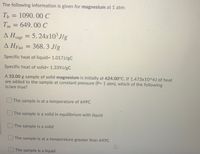
Chemistry
10th Edition
ISBN: 9781305957404
Author: Steven S. Zumdahl, Susan A. Zumdahl, Donald J. DeCoste
Publisher: Cengage Learning
expand_more
expand_more
format_list_bulleted
Concept explainers
Question

Transcribed Image Text:The following information is given for magnesium at 1 atm:
Th = 1090. 00 C
= 649.00 C
Im
= 5.24x10³J/g
A Hyap
= 368.3 J/g
A HFUS =
Specific heat of liquid= 1.017J/gC
Specific heat of solid= 1.339J/gC
A 33.00 g sample of solid magnesium is initially at 624.00°C. If 1.473x10^4J of heat
are added to the sample at constant pressure (P= 1 atm), which of the following
is/are true?
The sample is at a temperature of 649C
The sample is a solid in equilibrium with liquid
The sample is a solid
The sample is at a temperature greater than 649C
The sample is a liquid

Transcribed Image Text:In the laboratory a student finds that it takes 67.2 Joules to increase the temperature
of 10.1 grams of solid nickel from 20.2 to 36.0 degrees Celsius.
The specific heat of nickel calculated from her data is:
O 0.421J/gC
O-0.118J/gC
O-0.421J/gC
O0.118J/gC
Expert Solution
This question has been solved!
Explore an expertly crafted, step-by-step solution for a thorough understanding of key concepts.
This is a popular solution
Trending nowThis is a popular solution!
Step by stepSolved in 5 steps

Knowledge Booster
Learn more about
Need a deep-dive on the concept behind this application? Look no further. Learn more about this topic, chemistry and related others by exploring similar questions and additional content below.Similar questions
- Calculate the heat value for a 1.3 g Tungsten wire which is heated from 25.0°C to 50.3°C? Consider the specific heat capacity of Tungsten is 0.152 J g-10C¯1. 1.7 0.004arrow_forwardAn aluminum can of mass 0.14kg contains water at 17.5°C. Iron pellets with a total mass of 6.3kg at 85.1°C are dropped into the can, and the can and it's contents come to equilibrium af 32.9°C. Specific heat of water = 4190 J/(kg•°C). Specific heat of aluminum = 910 J/(kg•°C). Specific heat of iron = 470 J/(kg•°C). how many kilograms of water are in the can? (3 sig fig)arrow_forwardA 6.75g sample of gold (specific heat capacity of Au= 0.130 J/gC) is heated using 40.2 J of energy. If the original tempurature of the gold sample is 25.0 degrees Celsius, what is the final temperature?arrow_forward
- Find the total energy involved in converting 450.0g of water from -21°C to 35°C. Hvan Water = 40.7 KJ/mol Hrus Water = 6.01 KJ/mol Solid C =2.03 J/g°C water Liquid Cwater =4.184 J/g°C Gas Cwater 2.01 J/g°C O 235 KJ O 150 KJ O 85 KJ 255 KJarrow_forwardSUBJECT : GENERAL CHEMISTRY 2 TOPIC : HEAT AND CALORIMETRYarrow_forwardEthylene glycol (specific heat 2.42 J/g°C) is used as a coolant in automotive engines. Calculate the energy released (q) when 3.65 kg of ethylene glycol is cooled from 132 °C to 85 °C.arrow_forward
- 0.020 mole of gold metal that has a specific heat capacity of 2.10 J/g °C released 5.20 kJ of heat. Calculate the final temperature if the initial temperature of the metal is 312K.arrow_forwardWhen a 45.0 g sample of alloy at 100.0°C is dropped into 100.0 g of water at 25°C, the final temperature is 37°C. What is the specific heat of the alloy? Given that: sH2O = 4.184 j/g °Carrow_forwardHow much heat energy is needed to raise the temperature of 10.00 grams of solid aluminum (c = 0.90 J/g°C) by %3D 33°C? er]arrow_forward
arrow_back_ios
arrow_forward_ios
Recommended textbooks for you
 ChemistryChemistryISBN:9781305957404Author:Steven S. Zumdahl, Susan A. Zumdahl, Donald J. DeCostePublisher:Cengage Learning
ChemistryChemistryISBN:9781305957404Author:Steven S. Zumdahl, Susan A. Zumdahl, Donald J. DeCostePublisher:Cengage Learning ChemistryChemistryISBN:9781259911156Author:Raymond Chang Dr., Jason Overby ProfessorPublisher:McGraw-Hill Education
ChemistryChemistryISBN:9781259911156Author:Raymond Chang Dr., Jason Overby ProfessorPublisher:McGraw-Hill Education Principles of Instrumental AnalysisChemistryISBN:9781305577213Author:Douglas A. Skoog, F. James Holler, Stanley R. CrouchPublisher:Cengage Learning
Principles of Instrumental AnalysisChemistryISBN:9781305577213Author:Douglas A. Skoog, F. James Holler, Stanley R. CrouchPublisher:Cengage Learning Organic ChemistryChemistryISBN:9780078021558Author:Janice Gorzynski Smith Dr.Publisher:McGraw-Hill Education
Organic ChemistryChemistryISBN:9780078021558Author:Janice Gorzynski Smith Dr.Publisher:McGraw-Hill Education Chemistry: Principles and ReactionsChemistryISBN:9781305079373Author:William L. Masterton, Cecile N. HurleyPublisher:Cengage Learning
Chemistry: Principles and ReactionsChemistryISBN:9781305079373Author:William L. Masterton, Cecile N. HurleyPublisher:Cengage Learning Elementary Principles of Chemical Processes, Bind...ChemistryISBN:9781118431221Author:Richard M. Felder, Ronald W. Rousseau, Lisa G. BullardPublisher:WILEY
Elementary Principles of Chemical Processes, Bind...ChemistryISBN:9781118431221Author:Richard M. Felder, Ronald W. Rousseau, Lisa G. BullardPublisher:WILEY

Chemistry
Chemistry
ISBN:9781305957404
Author:Steven S. Zumdahl, Susan A. Zumdahl, Donald J. DeCoste
Publisher:Cengage Learning

Chemistry
Chemistry
ISBN:9781259911156
Author:Raymond Chang Dr., Jason Overby Professor
Publisher:McGraw-Hill Education

Principles of Instrumental Analysis
Chemistry
ISBN:9781305577213
Author:Douglas A. Skoog, F. James Holler, Stanley R. Crouch
Publisher:Cengage Learning

Organic Chemistry
Chemistry
ISBN:9780078021558
Author:Janice Gorzynski Smith Dr.
Publisher:McGraw-Hill Education

Chemistry: Principles and Reactions
Chemistry
ISBN:9781305079373
Author:William L. Masterton, Cecile N. Hurley
Publisher:Cengage Learning

Elementary Principles of Chemical Processes, Bind...
Chemistry
ISBN:9781118431221
Author:Richard M. Felder, Ronald W. Rousseau, Lisa G. Bullard
Publisher:WILEY